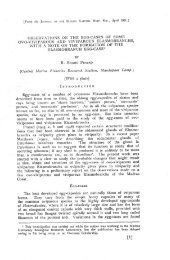PDF - Eprints@CMFRI
PDF - Eprints@CMFRI
PDF - Eprints@CMFRI
Create successful ePaper yourself
Turn your PDF publications into a flip-book with our unique Google optimized e-Paper software.
55<br />
There are two specimens in the present collection. They are composed of crowded clusters of repeatedly<br />
dividing branches, that undergo fusion. The lower part is dead, total height in one 8 cm, in the other<br />
only the living zone is preserved and is 4 cm high. Calices 0.5 to 0 .7 5 mm in diameter. Septa 12 , primaries<br />
subequal. Calices about 1 mm apart. The wall at the lower half of the corallite projects in the form of<br />
papillae. Under the lens the coenenchyme reveals a fine reticulum with slender spines that give a rough<br />
appearance to the coral.<br />
Ma terial:<br />
Gulf of Suez: T . Avi v S 8678,8684 (EI Bilaiyim).<br />
Dis tr i but ion: Red Sea ; Cook Islands (STODDART & PILLAI, 1973 ).<br />
R em ark s : The present specimens agree to the type in Berlin Museum (No. 2137). It is very likely<br />
that the present species is only a skeletal variation of M. circumvallata. The absence of free papillae is the<br />
major difference from M. circumvallata as is pointed out by KLUNZINGER .<br />
Porites<br />
Montipora<br />
Madrepom<br />
Montipora<br />
Porites<br />
Montipora<br />
Montipora circulllvallata (EHRENBERG), 1834<br />
( Plat~ 11, Figs. 1. 2)<br />
circumval1Qta 1834. EHR ENBERG. 339 (Type locaJity : Red Sea).<br />
circumvallata 1897. BERNARD, 87 (synonymy),<br />
1906. v. MARENZELLER, 62: pl~ 21170: 23170a.<br />
1967. SCHEER. 426.<br />
19S0. HEAD. 14S. +46.<br />
ahrotanoides IS2S. AUDOUIN (& SAVIGNV). 55 , pI. 4/4 .<br />
abrotanoides 1897. BERNARD, 110 (synonymy).<br />
crista galli IS34. EHRENBERG. 340.<br />
crista galli 1860. MJu.'lE EDWARDS (& HAIME ), 211.<br />
IS79. KLUNZINGER 2. J4 : pls. 516,6/1: 1015.<br />
IS97. BERNARD. 84.<br />
1967. NEMENZO. 17, pl. 5/ 1.<br />
denSQ 1906. v. MARENZELLER. 62; pI. 21 /69. 69a.<br />
mO,taSleriata 1879. KLUNZINCER 2, H i pls. 519:6/ 2; 10/6 (non FORSKAL).<br />
nudiceps 1879, KlUNZINGER 2. 33 .<br />
The material we place under this species superficially looks like a heterogeneous assemblage. In general<br />
the growthform is ramose, but some are arborescent and others are tufted cespitose with coalescent<br />
branches, sometimes fusing to semi-solid masses. We take a few examples to describe the skeletal variation.<br />
EC 357 is semi-arborescent with a total height of 12 cm and greater spread of 18 cm. The main branch<br />
divides to form many branches, upper branchlets either digitiform or a little flattened as in some specimens<br />
of M. divaricata. The calices at the lower branches and main divisions small , average 0.5 mm in diameter,<br />
bur larger and more conspicuous at the distal parts of the branches, where they are 0.7 to 0.8 mm in<br />
diameter. Sepra in twO cycles, primaries often meet at the centre of the fossa. The lower part of the<br />
calices possesses projecting papillae either in the form of a crescent or in some cases they form a ring<br />
around the calyx, I to 1.5 mm thick and high . The papillae resemble the labellate corallites of some<br />
Acroporae, particularly A. millepora. At certain parts the papillae are free , that is without close relation<br />
to calices, and they are conical, I to 2 mm thick at the base and just so in height. Two or three such<br />
papillae may fuse to form excrescences bearing calices, giving a rough appearance to the branch surface.<br />
EC 356 is also arborescent. But in this specimen the papillae are sometimes up to 3 mm thick and high .<br />
At the lower part of the main divisions papillae are not developed and the surface looks smooth.<br />
These two specimens differ from others in the collectio n in having arborescent coralla with well<br />
developed papillae. They agree in several respects to BER ARD's description of M. abrotanoides.<br />
NS 8405 has a cespitose corallum with branches expanding towards the top and fusing each other to<br />
form flat plates. The top of the branches bears smaller crispate branchlets. Calices 0.5 to 0.6 mm in diameter,<br />
I to 1.5 mm apart; septa 12 . At the older parts of the branches papillae are not well formed. In<br />
younger parts rhe lower wall of the coralli tes project , giving a nariform appearance. They are 1 to 1.5 mm<br />
in height and thickness at the base.
















